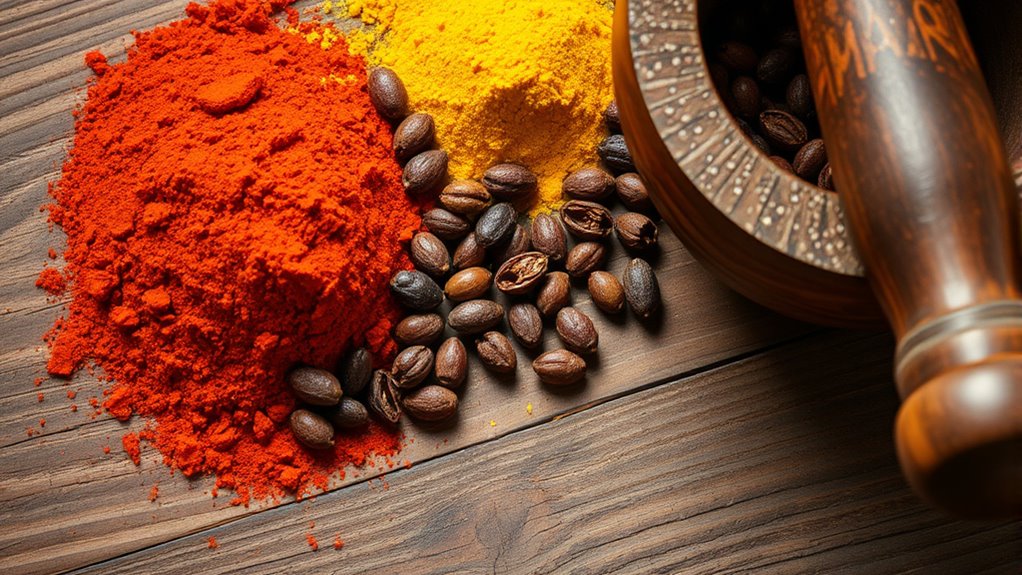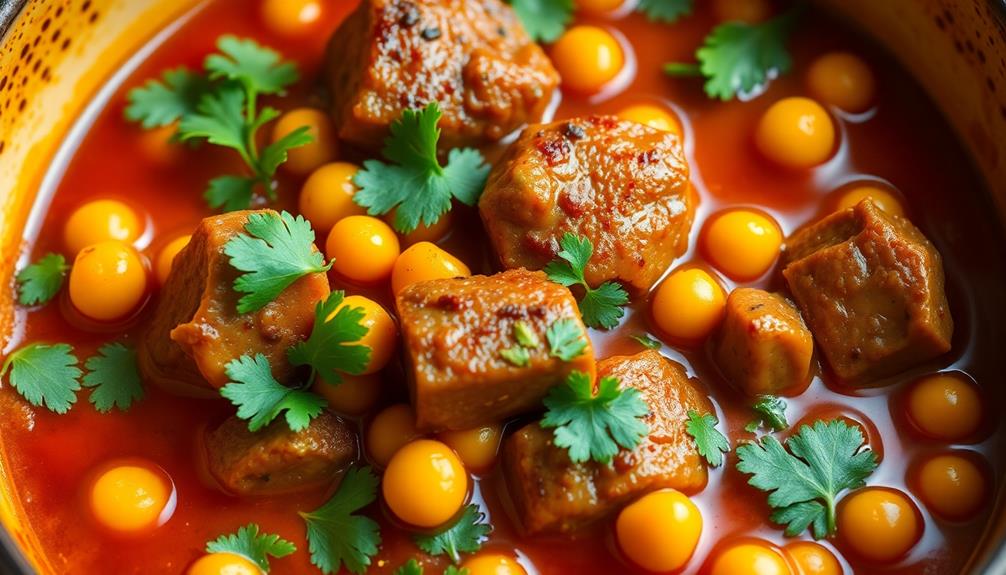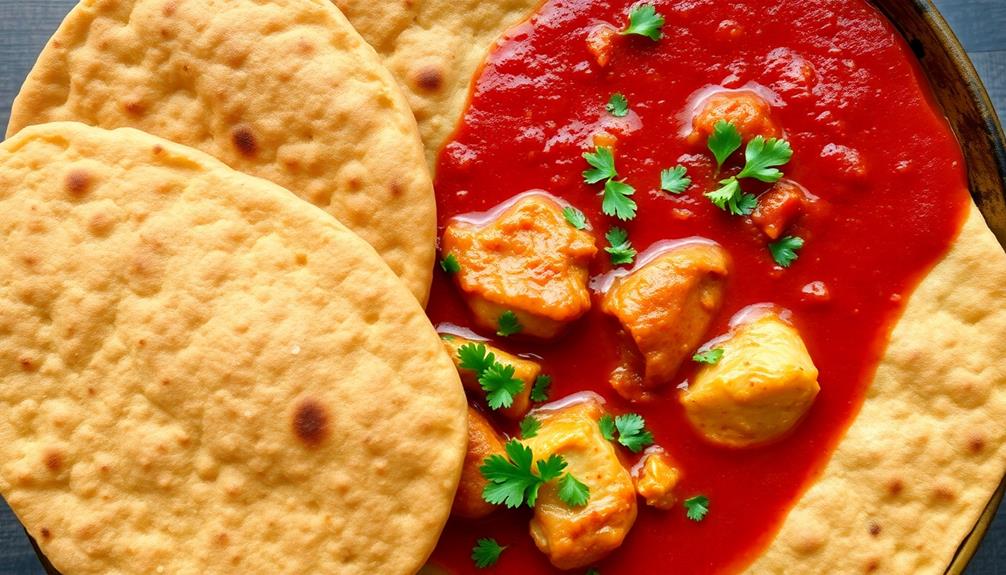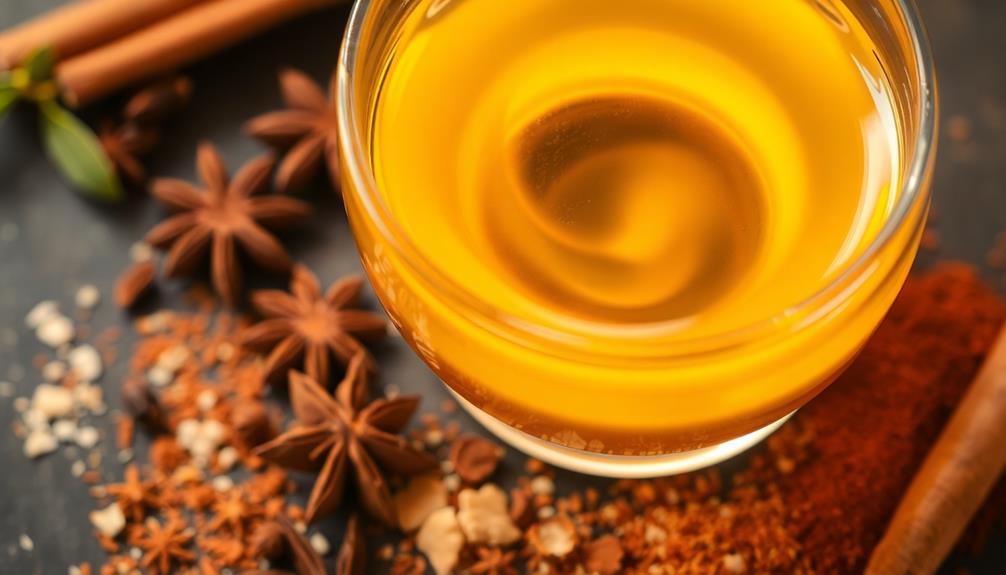To master Ethiopian berbere with balanced heat, start with a basic ratio of 1 part chili powder to 2 parts sweet spices like cinnamon and allspice. Adjust the chili to taste, adding gradually to avoid overpowering flavors. Focus on combining fresh spices and tasting as you go to find the perfect balance. Proper proportions make a flavorful, complex blend. Keep exploring these tips to refine your berbere and create authentic, well-balanced dishes.
Key Takeaways
- Start with a basic ratio, such as 1 part chili powder to 2 parts sweet spices like cinnamon and allspice.
- Gradually add chili to control heat, tasting as you go to achieve desired spiciness.
- Balance heat with aromatic spices like cardamom and fenugreek for depth without overpowering.
- Use fresh, vibrant spices to ensure a clear, well-rounded flavor profile.
- Store your Berbere in airtight containers away from light to maintain consistent heat and flavor.

Have you ever wondered what gives Ethiopian dishes their distinctive bold and spicy flavor? The answer lies in the Berbere spice blend, a cornerstone of Ethiopian cuisine that combines a complex mix of spices to create its signature heat and depth. But mastering Berbere isn’t just about mixing ingredients; it’s about understanding regional variations and knowing how to store your blend properly to preserve its vibrant flavor. A proper spice blend can elevate your cooking from ordinary to extraordinary, showcasing the versatility of Berbere in various dishes. Ethiopian Berbere varies considerably across regions, reflecting local ingredients, climate, and culinary traditions. For example, in the northern highlands, Berbere might feature a heavier emphasis on hot chili peppers, resulting in a spicier profile. Meanwhile, in the southern regions, the blend could incorporate more aromatic spices like cardamom and fenugreek, balancing heat with earthier notes. Recognizing these regional differences helps you tailor your Berbere to match authentic tastes or experiment with your preferred flavor profile. It also means that no single recipe is the definitive version—there’s room for personal adjustments based on regional influences or your taste preferences.
Getting the ratio of spices right is vital for achieving a balanced heat level. Too much chili powder, and your dish might become overwhelmingly spicy, masking other flavors. Too little, and it could lack the fiery punch that defines Ethiopian cuisine. Start with a basic ratio—say, one part chili powder to two parts sweet spices like cinnamon and allspice—and adjust according to your heat tolerance. Remember, it’s easier to add more heat gradually than to fix a dish that’s too spicy from the start. Tasting as you go is key, so you develop an intuitive sense of balance. Additionally, understanding spice freshness and how it impacts flavor can help you select the best ingredients for your Berbere. Using visual cues such as vibrant color can also guide you in assessing the quality and freshness of your spices. Once you find the perfect ratio, you’ll have a reliable base for countless recipes, from stews to grilled meats. Proper storage is critical for maintaining the freshness and potency of your Berbere. Keep your spice blend in an airtight container, ideally glass or ceramic, away from direct sunlight and heat sources. Exposure to air, light, or moisture can cause the spices to lose their vibrant aroma and flavor over time. A cool, dark pantry is ideal, and try to use your Berbere within six months for the best results. If you make a large batch, consider dividing it into smaller portions, so you only expose what you need each time. This approach helps your spice blend stay fresh longer and ensures every dish you prepare benefits from the bold, complex flavors of authentic Berbere. Additionally, understanding the role of color accuracy in spice blends can help you choose the right visual cues to assess freshness and quality.
Frequently Asked Questions
Can I Substitute Fresh Herbs for Dried in Berbere?
You can substitute fresh herbs for dried in berbere, but keep in mind that fresh herbs have more moisture and a milder flavor. Use about three times the amount of fresh herbs compared to dried, and consider herb drying techniques to preserve their flavor. Fresh vs. dried herbs each bring unique qualities, so taste as you go to maintain balance. Adjust the ratio accordingly for a flavorful, well-rounded spice blend.
How Long Does Homemade Berbere Stay Fresh?
Did you know homemade spices like berbere can last up to six months? For the best storage life and freshness tips, keep your berbere in an airtight container away from direct sunlight and heat. Proper storage preserves its vibrant flavor and heat. Check periodically for any signs of spoilage, and if it loses aroma or color, it’s time to make a fresh batch. Enjoy your spice blend while it’s at its peak!
Is Berbere Suitable for People With Spice Allergies?
If you have spice allergy concerns or berbere ingredient sensitivities, it’s best to avoid it or check the ingredient list carefully. Berbere contains multiple spices, which could trigger allergic reactions. Always read labels or make your own blend to control ingredients. If you’re unsure about spice allergy concerns, consult with a healthcare professional before trying berbere to ensure it’s safe for you.
Can Berbere Be Used in Desserts?
Did you know that some chefs are now using berbere in desserts? While traditionally spicy, berbere flavor variations sometimes include incorporating sweet spices like cinnamon and cardamom, making it versatile. You can experiment by adding a pinch to chocolate cakes or fruit compotes. Just be mindful of the heat level and balance it with sweetness, creating unique, flavorful desserts that highlight berbere’s complex profile.
What Are Common Mistakes When Blending Berbere?
When blending berbere, you might make mistakes that affect its spice level and ingredient ratios. For example, adding too much chili powder can make it excessively hot, while unevenly balancing spices like fenugreek and garlic can overpower other flavors. To avoid this, measure ingredients carefully and taste as you go. Keep the spice level in mind and adjust ratios gradually to create a well-balanced, flavorful berbere blend.
Conclusion
Just as a master musician balances each note to create harmony, you’ll find that perfect berbere blend when you tune each spice to your taste. Remember, the rhythm of heat and flavor is yours to compose—adjust, taste, and refine like a poet shaping their verse. With patience and practice, your spice mix will sing with the vibrant spirit of Ethiopia, turning every dish into a symphony of bold, balanced flavor that echoes through every bite.










